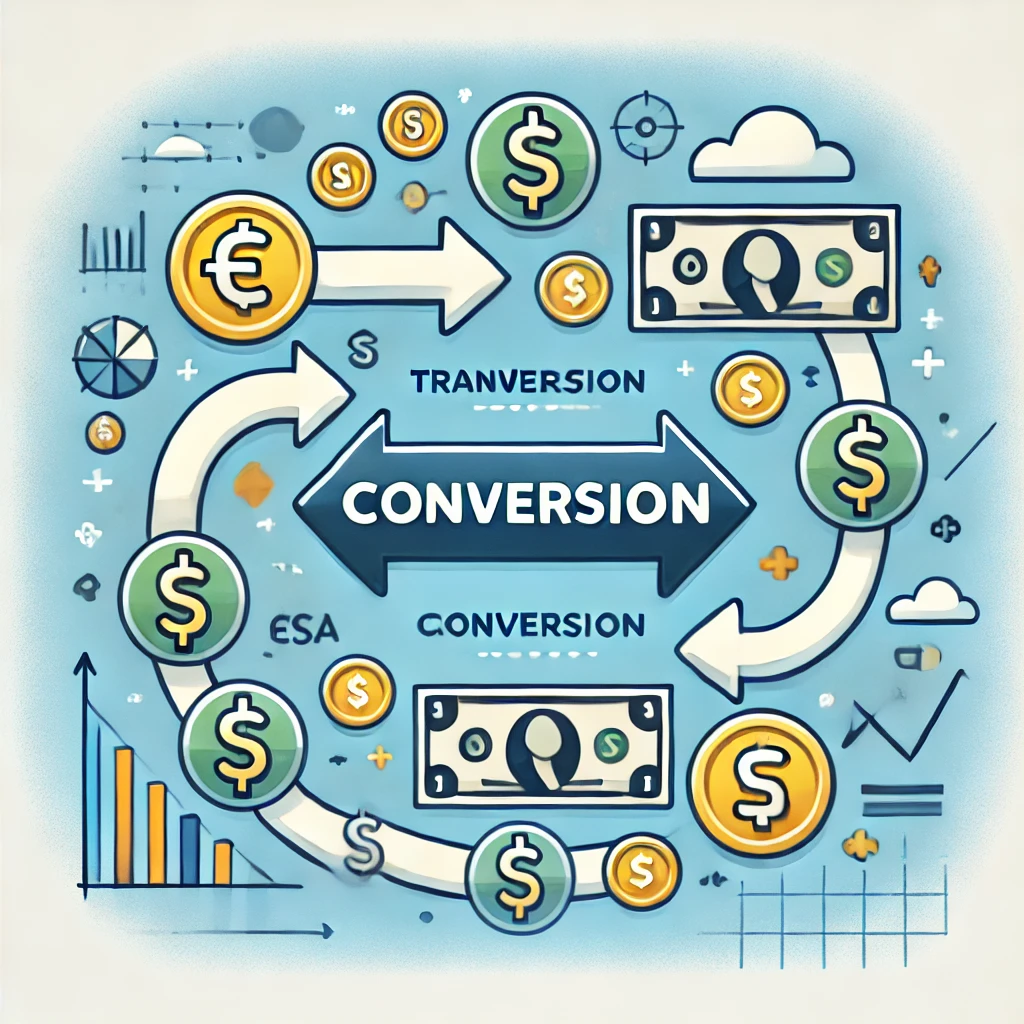From debt equity swaps to convertible securities master financial conversion
In the financial world, the term “conversion” carries significant weight. Whether you’re dealing with convertible securities, debt-equity swaps, or measuring conversion rates, understanding the various facets of conversion can provide valuable insights into financial management and investment strategies. This guide explores conversion’s definition, types, and practical applications, highlighting its importance in financial transactions and economic development.

Definition and purpose
What is conversion in financial terms?
Understanding conversion, in financial terms, is not just a matter of changing one form of financial instrument into another. It’s about gaining a strategic edge in financial management and investment opportunities. Whether it’s converting debt into equity, transforming securities, or even changing currencies, the overall significance of conversion lies in its ability to provide flexibility and strategic options for investors and companies.
Types of conversions
Financial conversions
Financial conversions encompass a variety of transactions, each with its purpose and mechanism. Key types include:
- Convertible securities are financial instruments, such as bonds or preferred shares, that can be converted into a specified number of common shares.
- Debt equity swaps: A company’s debt is exchanged for equity, turning creditors into shareholders.
- Other financial instruments: This can include converting currencies, commodities, or other assets based on specific financial strategies.
Understanding conversion in convertible securities
Convertible securities, such as convertible bonds and preferred shares, offer investors the option of conversion, allowing them to exchange their holdings for a set amount of the issuing company’s equity. Typically, bondholders choose to convert when the value of shares received through conversion surpasses the bond’s current worth.
For example, if Jill owns a convertible bond from XYZ Corp. that allows conversion to 100 shares, she may opt to convert when XYZ’s share price exceeds $10, as this increases her investment value. The conversion ratio or price—often set in the bond’s trust indenture—determines how many shares can be received per bond.
Preferred shares also include conversion options, letting investors exchange preferred stock for common stock if it’s advantageous. The share prospectus specifies the conversion ratio, indicating how many common shares each preferred share can convert into.
For instance, if Jane buys a preferred share for $100 with a conversion ratio of four, she can convert it to four common shares. This implies a conversion price of $25, making conversion favorable if the common share price rises above $25.
Conversion is typically at the holder’s discretion, but sometimes companies also have rights to initiate conversion. Regardless of who initiates it, converting preferred stock to common stock impacts the overall equity structure by diluting existing shareholders’ ownership percentage.
New stock from conversions increases outstanding shares, which can affect voting rights, earnings per share (EPS), and individual share value as ownership is redistributed among more shares.

Debt equity swap transactions
Introduction to debt-equity swaps
Debt-equity swaps are financial transactions where a company’s debt is exchanged for equity. This process is often used to restructure a company’s capital, reduce debt, and improve economic stability.
Critical elements of debt-equity swap transactions
Critical factors in debt-equity swaps include the valuation of debt and equity, negotiation terms, and the impact on the company’s financial statements and shareholder structure.
Mechanism: converting debt to equity
In a debt-equity swap, the company offers shares to its creditors in exchange for cancelling the debt. This makes creditors and shareholders align their interests with the company’s long-term success.
Corporate debt and equity
Corporate debt refers to the money bora company borrows, while equity represents ownership. The dynamic between these two forms of capital is crucial for understanding investment strategies and financial health.
Importance in Nigeria
In Nigeria, debt-equity financing has played a pivotal role in economic development. It has provided companies with an alternative means of raising capital, reduced financial distress, and supported economic growth.

Conversion methods
Definition of conversion method in accounting
The conversion method in accounting is not just a theoretical concept. It’s a practical tool that involves changing one form of financial record or instrument into another, essential for accurate financial reporting and management. Understanding and applying this method can significantly enhance your financial knowledge and decision-making.
Steps involved in the conversion method
- Identify the items to be converted: Determine which financial records or instruments need conversion.
- Calculate the conversion rate: Establish the rate or value at which the conversion will occur.
- Record the conversion: Make the necessary entries in the financial records.
- Review and validate: Ensure the accuracy and completeness of the conversion process.
Use cases
The conversion method is applicable in various scenarios, including currency conversion, asset revaluation, and adjusting financial statements for mergers and acquisitions.
Benefits of using the conversion method
- Accuracy: Ensures precise financial reporting.
- Flexibility: Provides options for financial management and strategic planning.
- Transparency: Enhances the clarity of financial statements.
Practical examples
- Currency conversion: Converting foreign currency transactions to the local currency for accurate financial reporting.
- Asset revaluation: Adjusting the value of assets to reflect current market conditions.
Conversion values
What is conversion value?
Conversion value represents the worth of a convertible security if it were converted into common stock. It is crucial for investors as it helps determine the potential benefits of conversion. Essentially, it is the value that an investor would receive if they chose to convert their security into common stock at the current market price.
Calculation of conversion value
Conversion value is calculated using the formula:
Conversion value=Conversion ratio×Current stock price\text{Conversion value} = \text{Conversion ratio} \times \text{Current stock price}Conversion value=Conversion ratio×Current stock price
The conversion ratio is the number of shares an investor receives upon conversion.

Factors affecting conversion value
Several factors influence conversion value, including the current stock price, market conditions, and the terms of the convertible security.
Practical examples
- Convertible bonds: If a bond can be converted into 10 shares of stock and the current stock price is $50, the conversion value is $500.
- Preferred shares: Similar calculations apply, considering the conversion ratio and current stock price.
Application in financial decision-making
Conversion value is not just a number. It’s a powerful tool that aids investors in deciding whether to convert their securities or hold onto them, based on potential profitability and market conditions. By understanding and leveraging conversion value, investors can make informed and confident decisions about their investment strategies.
Conversion rates
What is a conversion rate?
Conversion rate refers to the percentage at which a given action or outcome is achieved. In finance, this can relate to the conversion of securities, currencies, or even customer conversions in a business context.
Calculation of conversion rates
Conversion rates are calculated by dividing the number of successful conversions by the total opportunities for conversion, then multiplying by 100 to get a percentage.
Practical examples
- E-commerce: The ratio of completed purchases to the number of website visitors.
- Securities: The percentage of convertible bonds that have been converted into stock.
Importance of conversion rates
Conversion rates are vital for evaluating the effectiveness and efficiency of financial instruments, marketing strategies, and operational processes. They provide a clear measure of how well a particular strategy or process is performing, allowing for adjustments and improvements to be made where necessary.
Improvement strategies
- Optimise processes: Streamline procedures to enhance conversion efficiency.
- Enhance value propositions: Improve the offer’s attractiveness to increase conversion rates.
- Monitor and adjust: Continuously track performance and make necessary adjustments.
Understanding conversion rates
Conversion rates reflect the amount of one currency needed to acquire a unit of another currency. For instance, if the conversion rate between the U.S. dollar (USD) and the euro (EUR) is 1.20, then 1 EUR can be exchanged for 1.20 USD. This means you’d need 1.20 USD to buy 1 EUR.
Conversion rates are categorized as either fixed or floating:
- Fixed conversion rates are determined by a government or central bank and remain stable over time. For example, several currencies use the USD as a peg.
- Floating conversion rates, also known as exchange rates, are determined by the foreign exchange market. These rates fluctuate based on supply and demand, economic conditions, and political factors.
Because a conversion rate indicates the value of one currency in terms of another, it also reflects the supply and demand dynamics for each currency. Factors influencing currency values include economic performance, central bank interest rates, and government policies.
If the supply of a currency grows faster than the demand from consumers or investors, its value tends to decrease in foreign exchange markets. This may result in an increase in its conversion rate relative to other currencies. Governments or central banks may adjust the money supply to influence the conversion rate, using strategies such as economic stimulus or austerity measures.
Interest rate policies also impact demand; if a currency’s interest rates rise, demand for that currency may increase as individuals and institutions shift assets into it. Additional factors affecting conversion rates include trade balance, inflation expectations, and political stability.
Debt conversion for humanitarian and climate impact
Introduction to debt conversion for humanitarian and climate impact
Debt conversion for humanitarian and climate impact involves restructuring debt to support environmental and social projects. This innovative approach helps address global challenges while managing financial obligations.
Mechanism of debt conversions
In these conversions, creditors agree to reduce or forgive a portion of a country’s debt in exchange for commitments to invest in specific projects, such as climate action or social programs.
Benefits of debt conversions
- Support for development: Provides funding for essential projects.
- Debt relief: Reduces the financial burden on debtor countries.
- Sustainable impact: Promotes long-term environmental and social benefits.
Case studies
- Bolivia’s debt-for-nature swaps: Successfully converted debt into funding for conservation projects.
- Philippines’ debt-for-education: Reduced debt while investing in educational infrastructure.
Challenges and solutions
- Coordination: Requires collaboration between governments, creditors, and NGOs.
- Transparency: Ensures that funds are used for intended purposes.
- Sustainability: Focuses on long-term impact rather than short-term gains.
Convertible debt instruments in international tax law
Introduction to convertible debt instruments
Convertible debt instruments are financial tools that allow investors to convert debt into equity. These instruments provide flexibility and potential upside for both issuers and investors.
Tax implications
The tax treatment of convertible debt can vary widely across jurisdictions, impacting both the issuer and the investor. Key considerations include:
- Interest deductibility: Whether interest payments on convertible debt are deductible.
- Capital gains: Taxation on the conversion of debt into equity.
- Withholding taxes: Applicable on interest payments to foreign investors.
International context
International tax laws play a significant role in the issuance and conversion of convertible debt. Differences in tax regulations can affect the attractiveness and feasibility of these instruments in different countries.
Case studies
- U.S. convertible bonds: Detailed analysis of tax implications and regulatory frameworks.
- European markets: Comparison of tax treatments and legal requirements.
Regulatory aspects
Legal and regulatory frameworks governing convertible debt include securities laws, tax codes, and financial regulations. Compliance with these rules is essential for successfully issuing and converting debt instruments.
Summary of key points
Understanding the various aspects of conversion in financial terms provides valuable insights into investment strategies, financial management, and economic development. From debt-equity swaps and conversion methods in accounting to calculating conversion values and rates, each facet plays a critical role in the financial ecosystem.
Relevance to modern economics
In today’s dynamic economic landscape, conversion mechanisms offer flexibility and strategic options for managing financial assets and liabilities. They support economic growth, enhance investment opportunities, and address global challenges through innovative approaches like debt conversions for humanitarian and climate impact.
Future research directions
Future research could explore the impacts of emerging financial technologies on conversion processes, the role of regulatory changes in shaping conversion practices, and the long-term effects of innovative debt conversion projects on sustainable development.
Recommendations for further reading
To deepen your understanding of financial conversion and its implications, consider exploring the following resources:
FAQs
What is financial conversion, and why is it significant?
Financial conversion refers to changing one form of financial instrument into another, such as converting debt into equity or transforming securities. It is significant because it provides flexibility and strategic options for investors and companies, enhancing financial management and investment opportunities.
How do debt-equity swaps work?
Debt-equity swaps involve exchanging a company’s debt for equity, making creditors shareholders. This process helps restructure a company’s capital, reduce debt, and improve financial stability.
What are the steps involved in accounting conversion methods?
The steps include identifying the items to be converted, calculating the conversion rate, recording the conversion, and reviewing and validating the process to ensure accuracy and completeness.
How is conversion value calculated, and why does it matter?
Conversion value is calculated using the formula:
Conversion value=Conversion ratio×Current stock price\text{Conversion value} = \text{Conversion ratio} \times \text{Current stock price}Conversion value=Conversion ratio×Current stock price
It helps investors determine the potential benefits of converting their securities into common stock.
What are the benefits of debt conversion for humanitarian and climate impact?
Debt conversion for humanitarian and climate impact supports development by providing funding for essential projects, offers debt relief to debtor countries, and promotes long-term environmental and social benefits.


